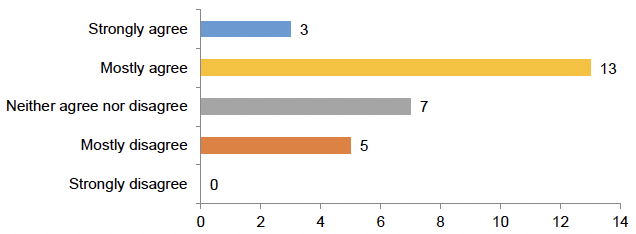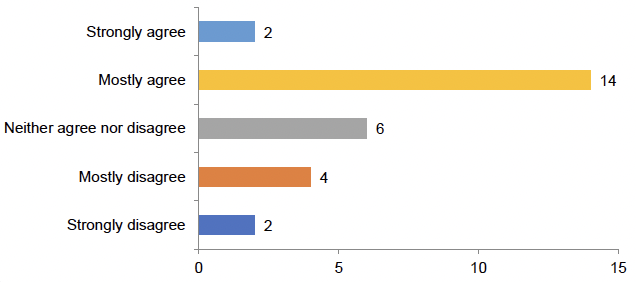Health and social care - integration authority guidance: consultation analysis
Consultation analysis report, following the consultation on health and social care integration authority planning and performance reporting statutory guidance.
3. Analysis of responses to Section 1 – Strategic plans: statutory guidance
3.1 Structure of the guidance
The draft guidance is ‘statutory guidance’ by virtue of section 53 of the 2014 Act, which states that those persons cited ‘must have regard to any guidance issued by the Scottish Ministers about its functions under or in relation to this Act’. This is communicated on page one of the draft guidance.
The draft guidance seeks to balance outlining the relevant requirements under the 2014 Act and related regulations with supplementary information intended to support integration authorities effectively perform the duties and draw links to wider supporting resources. The additional information is set apart, presented in boxes, throughout the guidance.
Chart 1 and Table 1, below, summarise responses to the initial question on the structure of the guidance. The majority of responses ‘mostly agree’, with ‘neither agree nor disagree’ being the second most common response. Overall, with 57% of the responses ‘mostly’ or ‘strongly’ agreeing and 18% ‘mostly’ disagreeing, there appears to be support for the approach taken in structuring the guidance.

Table 1. Do you agree that presenting supporting information in boxes throughout the guidance is a useful structure?
- Strongly agree
- Total: 3
- 10.7% total
- Mostly agree
- Total: 13
- 46.4% total
- Neither agree nor disagree
- Total: 7
- 25% total
- Mostly disagree
- Total: 5
- 17.9% total
- Strongly disagree
- Total: 0
- 0% total
- Total
- Total: 28
Further feedback was received through the subsequent open-ended question, ‘If you have any further thoughts or suggestions on how the structure of the guidance can be improved, please tell us here’. The main points from the 19 responses included:
- the guidance is long, and the additional information presented in boxes could be streamlined
- some health and social care partnerships (HSCPs) responded that the guidance is too focused on the legislation, which they consider dated
- some HSCPs responded that some of the legislative requirements communicated in the guidance, centred on national outcomes, frustrate or contradict input and priorities from local partners they engage with
- the formatting to separate certain information in boxes is present in the PDF version of the document but not on the website version, which may be a barrier to accessibility
- specific feedback on the wording and placement of additional information boxes
- uncertainty on the ‘statutory’ labelling of the guidance
3.2 Balance of information within the guidance
The next questions centred on the balance of information between summarising the statutory requirements with wider supporting information throughout the guidance.
Chart 2 and Table 2, below, summarise the responses to the question on the balance of information. The majority of responses ‘mostly agree’ with the balance of information. Overall, with 57% of the responses ‘mostly’ or ‘strongly’ agreeing and 21% ‘mostly’ or ‘strongly’ disagreeing, there appears to be support for the balance of information within the guidance.

Table 2. Do you agree that there is an appropriate balance between information summarising the relevant statutory requirements in the Public Bodies (Joint Working) (Scotland) Act 2014 and wider information to support integration authorities meet these requirements?
- Strongly agree
- Total: 2
- 7.1% total
- Mostly agree
- Total: 14
- 50% total
- Neither agree nor disagree
- Total: 6
- 21.4% total
- Mostly disagree
- Total: 4
- 14.3% total
- Strongly disagree
- Total: 2
- 7.1% total
- Total
- Total: 28
Further feedback was received through the subsequent open-ended question, ‘If you do not think that the balance of information in the guidance is appropriate, please tell us here what changes you would recommend and why’. The main points from the 16 responses included:
- some HSCPs responded that the guidance is too focused on the legislation
- a few responses stated the guidance is balanced, comprehensive and appreciated the detail of the statutory requirements
- suggestions to re-structure the guidance to locate information centred on reviewing a strategic plan closer to the beginning, recognising that this information will be of immediate use to those using the guidance
- contradictory feedback, with some responses noting the guidance recognises the complex landscape that integration authorities operate within and others stating more support is required on links with wider areas, such as community planning partnerships and NHS health boards
- the inclusion of the specific information such as the Community Health and Social Care Integrated Services Framework and practices on involving those with lived experience is welcome
- some HSCPs responded that some of the legislative requirements communicated in the guidance, centred on national outcomes, frustrate or contradict input and priorities from local partners they engage with
- the addition of the checklist in annex C is welcome
3.3 Suggested improvements and other feedback
The final questions centred on suggestions on whether information can be improved or is potentially missing from the guidance, followed by the opportunity to provide any other feedback.
In response to whether information can be improved or is missing, the main points from the 19 responses included:
- suggestions to reduce, condense and streamline information
- some requests for good practice examples
- requests for further links to wider planning duties
- requests and suggestions to alter specific sections and wording
- the guidance could encourage HSCPs to evaluate their existing planning and engagement arrangements
- recognition that the language and advice around participation and engagement has been strengthened
- recognition that the guidance places an emphasis on encouraging accessible outputs
- suggestion that integration authorities should evidence lived experience involvement in their strategic plans
- more should be done in addressing the lack of third sector provider involvement in local planning processes
In relation to other feedback, the main points from the 20 responses included:
- a route for those using the guidance to provide feedback on broken links or outdated resources could be useful
- light-touch updates to the guidance should take place every few years
- the revisions to the guidance are helpful, focusing on key information while linking to wider resources
- concern that the guidance is not clear on whether it is about developing an effective strategic plan, aligned to legislation, or a guide to strategic planning more generally
- some HSCPs noted that the national health and wellbeing outcomes and related indicators are not always relevant or useful
- the potential impact of the national care service development on the guidance
Contact
Email: integration@gov.scot
There is a problem
Thanks for your feedback